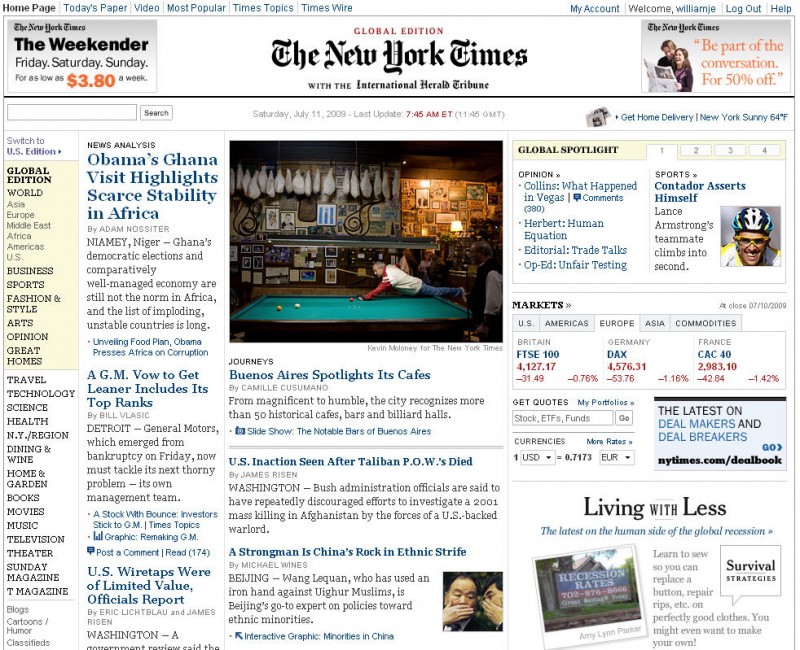Selling Online News
 Having apparently learned nothing from its TimesSelect debacle wherein, by charging a nominal fee to read its opinion columnists, the NYT ensured no one read said columns much less linked to them, the paper is floating a trial balloon of charging $5 a month to read its online edition.
Having apparently learned nothing from its TimesSelect debacle wherein, by charging a nominal fee to read its opinion columnists, the NYT ensured no one read said columns much less linked to them, the paper is floating a trial balloon of charging $5 a month to read its online edition.
Michael Crowley is enthusiastic:
Given that some people spend $5 per day on coffee, paying that much per month for online access the best newspaper in the world strikes me as an absolute no-brainer. I myself would pay twice as much. I hope the idea catches on, and I hope this marks a shift from the days of newspapers panicking to the start of successful new business models.
Matt Yglesias, however, injects a note of sober economic analysis:
A big part of the selling point of The New York is that it’s “the best newspaper in the world.” I can see why you would pay money to read the best newspaper in the world. But why would you pay money to read the sixth-best newspaper in the world?
[…]
Note that BBC News runs the world’s second-best international news website and they don’t charge anything and show no sign of ever needing to charge. That’s not the kind of firm you want to compete against.
Quite right. Charging for access to generic, perishable content is a sure way to ensure its irrelevancy. The only way NYT could get away with it would be to band together with all the other quality news providers and form some sort of cabal that all charged for access. And even then, I’m not sure we wouldn’t get around it.
I’d gladly pay $5 a month to have the NYT delivered to me via the magic of the Internet. If this were 1995. Back then, the prospect of getting “the best newspaper in the world” delivered to my house and office in an electronic format that I could easily save and share would have been exciting. Fast forward a few years, though, and there’s an amazing array of great content available for free on the Web. The only limitation is my ability to find and read it all.
In early 2003, when I started this blog, I used to read the NYT, WaPo, Slate, RealClearPolitics, and several other sites every day. Soon, I was also checking out 40 or more blogs a day via my blogroll. Somewhere along the way, however, I quit doing that. Because of various aggregation techniques that I employ, virtually everything I read online is at the individual page level and it’s generally irrelevant to me which organization produced the news. That is to say, I read content, not newspapers.
Contrary to the views of many of my brethren on the right, I continue to think NYT is a superb paper that produces an extraordinary amount of outstanding content on a daily basis along with the occasional dreck. But it’s not indispensable. There’s just too much great content out there, even if others produce it in smaller amounts and ratios. Indeed, I wouldn’t much notice if it were gone.






I’d pay $5.00/year. I’d pay that for WaPo, LA Times, and a few others.
I think the need for micro-payments is larger than ever, but the right technology has yet to appear.
There are tons of places for which I’d pay a very small sum (measured in mils, not cents) to read an article, but I’m not ponying up $7.00 for some archived newspaper article.
Micro-payments would also permit the ultra-expensive scholarly journals to reach a far wider audience than their hundreds or thousands of dollars per year subscriptions now do.
The only successful “for pay” sites on the Internet are porn sites.
I’d probably pay the $5 per month for the online NYT, but only if I could do it on a payment-by-payment basis (meaning I could decide to pay for it one month, then not the next month).
The main thing that burned me on most magazine subscriptions is the way they lock you into a long contract period.
International news and pornography. It could work.
Given that the NY Times is also referred to as “The Gray Lady”, that would suggest some kind of fetish site. That might limit the appeal, but demand higher prices.
The porn angle is interesting, but I would think they would have to down-size. They already have too many News Pimps, Whores, and Prostitutes on staff.
Listen, these people could not give away their News and remain profitable with a good subscription and advertising base. They have lost a lot of the people who used to read newspapers. People just don’t trust and like them anymore, is one reason. Other reasons certainly come into the equation; but foremost, people don’t like to spend money with people they don’t like and don’t trust.
US News and World Report charges $19.95 for a subscription to their pdf magazine delivered on Friday Afternoon – plus a monthly special issue and access to their website. Compared to this $5 per month seems to be too much.